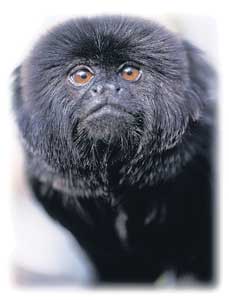
Monkeys in the real world
Monkeys have been revered in myth and popular culture for millennia, but today's real monkeys are having a hard time even surviving. In fact, 25 percent of the world's 650 species and subspecies of monkeys and other primates, are threatened with extinction, according to a report by the International Union for the Conservation of Nature. "More and more, mankind's closest living relatives are being cornered into shrinking areas of tropical forests," said Russell A. Mittermeier, the President of Conservation International and a prominent primatologist upon the release of the report in 2005. The problem is widespread. The 25 most endangered species noted in the report included the brown spider monkey of Colombia, the Cross River gorilla of Nigeria and Cameroon and the golden-headed langur of Vietnam. Humans are destroying the forests in which monkeys can live, as more and more people seek firewood, farmlands and natural resources. Hunting for bush meat and the pet trade are also factors. Poverty contributes to the problem as the forest provides impoverished families with their only source of firewood. Monkeys play a key role in the health of forest ecosystems. They disperse fruit seeds and other foods they consume helping to support a wide range of plant and animal life that make up our planet's forests. And they are remarkably like us. In a number of countries, children can count on a monkey as an early playmate. Monkeys have a great gift for grabbing and grasping objects with their hands and feet. They have five toes and five fingers, except for the spider monkey which has only four fingers. International treaties aim to stem the tide in illegal buying and selling of wildlife. Support is increasing. The ground-breaking 1973 Washington Convention grew from 23 supporting countries at the start to 121 countries today. Enforcing such agreements remains a problem. "Southeast Asia's primates are subject to relentless poaching because of the profits to be made from the illegal trade," said Chantal Elkin, manager of the Threatened Species Program in Conservation International's Center for Applied Biodiversity Science. "It is the duty of good zoos internationally to try not to allow species to become extinct," explains Stewart Muir the founder of the tiny Shaldon Wildlife Trust on the southwest coast of Great Britain. The Trust is recognized internationally as one of the finest breeding centres for rare and endangered small mammals. Over 400 animals have been born here, including lemurs, saki monkeys and tiny primates like pygmy marmosets. In a word... PRIMATE – A mammal characterized by refined development of the hands and feet, a shortened snout, and a large brain. A "primatologist" studies everything about monkeys and other primates. |
|| Front
Page | News
| Editorial
| Columns
| Sports
| Plus
| Financial
Times | International
| Mirror
| TV
Times | Funday
Times|| |
| |
Copyright
2007 Wijeya
Newspapers Ltd.Colombo. Sri Lanka. |
